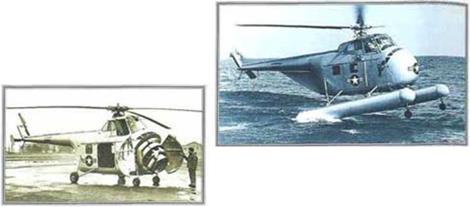S-55/H-19
• Korea veteran • Pioneering troop-lifter • Air-sea rescue
The S-55 was the first in a long line of successful large Sikorsky helicopters. Starting life as a piston-powered machine with a limited load-carrying capacity, the S-55 later received a turbine ongine and considerably more capability. It could perform a variety of roles, including airlifting troops, air-sea rescue work, air taxiing, cargo-hauling and anti-submarine patrol. The S-55 took part in the Korean War, but was still providing useful service to military and civil users in the 1980s.
T Piston power

 The large, bulky radial was faired under twin clamshell doors. Engineers loved this as it meant easy access to the engine. But the mamago of helicopters and large piston ongines was never realty successful.
The large, bulky radial was faired under twin clamshell doors. Engineers loved this as it meant easy access to the engine. But the mamago of helicopters and large piston ongines was never realty successful.
 Troop carrier ►
Troop carrier ►
The S-55’s ability to carry up to 10 fully-equipped troops was used in the development of an entirely new kind of warfare known as helicopter assault. Troop-carrying S-55s saw action around the world.
from Malaya to Algeria.
Load-lifter ►
Hauling logs in the Rockies was another task that earlier helicopters wore not capable of. The need for a powerful lurbino engine was demonstrated vividly when carrying loads at high altitudes.
Sling load supplies ►
The ability to get supplies to troops miles from any airfield was especially useful in Korea, where UN units were frequently bypassed and surrounded. Tho narrow fuselage profile made underslung load – carrying preferable to using the tight cabin space.
FACTS AND FIGURES
> The US Army version of tho H-19 was known as the Chickasaw.
>■ The US Navy HOS-4 version was used for anti-submarine warfare duties.
► French S-55s in Algoria used rockets and
machine-guns in combat trials.
>■ The US Army was still using its last few H-19s In the earty 1980s.
► Wostland-built S-55s were sometimes powered by the AJvis Leonides Major piston engine or Gnome turboshaft.
► In an air show stunt that went wrong, an RAF Whirlwind dragged a stuntman on a bicycle through trees.
|
|













